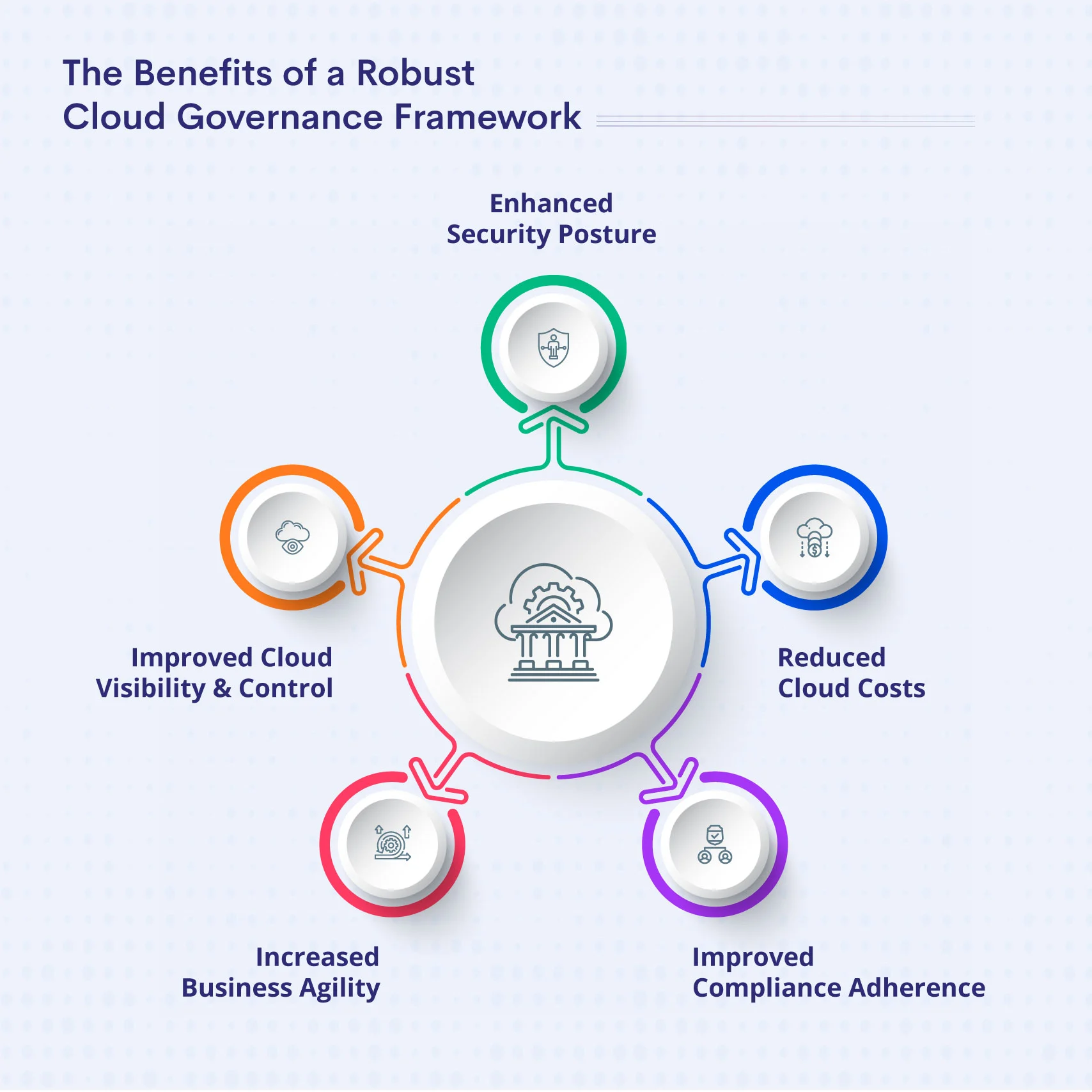- Blog
- April 3, 2024
Cloud Governance: The Definitive Guide for Modern Businesses

- Blog
- April 3, 2024
Cloud Governance: The Definitive Guide for Modern Businesses
In today’s fiercely competitive business landscape, harnessing the power of the cloud is no longer a choice, it’s a necessity. Cloud computing offers undeniable advantages – agility, scalability, and cost-effectiveness – that propel businesses toward greater efficiency and innovation. However, this newfound freedom comes with the crucial responsibility of managing and securing this dynamic environment. This is where the concept of cloud governance emerges as a cornerstone for success.
Cloud Governance: A Holistic Approach to Cloud Management
Cloud governance encompasses the comprehensive set of policies, processes, and tools that govern the effective and secure use of cloud computing services. It’s about striking a delicate balance – establishing control over your cloud infrastructure while fostering innovation and agility.
The Imperative for Cloud Governance
For modern businesses, implementing a robust cloud governance framework is no longer optional. Here’s why it’s imperative:
- Mitigating Security Risks: The cloud introduces a new attack surface, making robust security strategies a paramount concern. Cloud governance establishes processes for access control, data protection, and incident response, safeguarding your valuable assets.
- Optimizing Cloud Spend: Cloud services often utilize a pay-as-you-go pricing model. Cloud governance empowers you to track and optimize your cloud spending by identifying underutilized resources and preventing shadow IT, resulting in significant cost savings.
- Ensuring Compliance Adherence: Businesses operate within a complex web of regulations. Cloud governance ensures your cloud environment meets these regulatory requirements, mitigating the risk of hefty fines and reputational damage.
- Boosting Operational Efficiency: Standardized workflows and simplified cloud resource management, facilitated by cloud governance, lead to increased efficiency and improved productivity across your organization.
Building a Secure and Scalable Cloud Governance Framework
While the specifics of your cloud governance framework will be tailored to your unique needs, there are core components that form the foundation:
- Vision & Strategy: Clearly define your cloud governance goals, outlining what you aim to achieve with this framework.
- Role Distribution: Assign clear roles and responsibilities for cloud governance activities. Who owns which aspects, and who makes crucial decisions?
- Policy & Standards Development: Establish comprehensive policies for security, access control, data management, and resource allocation.
- Compliance Integration: Seamlessly integrate compliance requirements into your cloud governance framework.
- Process & Procedure Documentation: Define workflows for provisioning, managing, and decommissioning cloud resources.
- Metrics & Reporting Establishment: Identify key performance indicators (KPIs) to track the effectiveness of your cloud governance framework.
Best Practices for Effective Cloud Governance
- Leveraging Cloud Cost Management Techniques: Implement tools for proactive monitoring and optimization of cloud spending.
- Enforcing Rigorous Identity and Access Management (IAM): Implement robust IAM practices to control access to cloud resources with granularity.
- Prioritizing Data Security & Privacy: Put in place robust data encryption and security best practices to safeguard sensitive information.
- Standardizing Cloud Resource Management: Establish standardized processes for provisioning, managing, and decommissioning cloud resources.
- Maintaining Continuous Compliance Management: Regularly assess your cloud environment for compliance with relevant regulations.
- Utilizing Cloud Security Posture Management (CSPM): Utilize CSPM tools for continuous monitoring of your cloud environment for security vulnerabilities.
The Benefits of a Robust Cloud Governance Framework:
A well-defined and rigorously enforced cloud governance framework unlocks a multitude of benefits for your business:

- Enhanced Security Posture: Minimized risk of data breaches and cyberattacks through robust security measures.
- Reduced Cloud Costs: Optimized cloud spending by identifying and eliminating waste and inefficiencies.
- Improved Compliance Adherence: Peace of mind knowing your organization adheres to industry regulations and data privacy laws.
- Increased Business Agility: Streamlined cloud resource management fosters innovation and agility within your organization.
- Improved Cloud Visibility & Control: Gain greater visibility and control over your entire cloud environment.
Cloud Governance Tools & Technologies
Embracing modern advancements in technology is key to fortifying your cloud governance strategies. Below are pivotal tools and technologies to consider integrating:
- Cloud Management Platforms (CMPs): These platforms serve as centralized hubs for overseeing and regulating cloud assets across diverse cloud service providers. Offering features like resource allocation, monitoring, and automation, CMPs empower organizations to maintain comprehensive control and visibility over their cloud environments.
- Cloud Cost Management Tools: Effectively managing cloud expenses is paramount for optimizing budgets and maximizing returns. Cloud cost management tools provide real-time tracking and analysis of cloud expenditures, furnishing insights into usage trends and opportunities for cost reduction. By enabling budget allocation, resource optimization, and expenditure optimization, these tools ensure fiscal prudence in cloud operations.
- Identity and Access Management (IAM) Tools: IAM tools are instrumental in upholding security and regulatory compliance in the cloud. They facilitate the administration of user identities, access controls, and security policies for cloud resources. Simplifying processes such as user provisioning, authentication, and authorization, IAM tools uphold data integrity and confidentiality by restricting access to authorized users only.
- Cloud Security Tools: Safeguarding cloud assets against cyber threats demands dedicated cloud security tools. These tools furnish a suite of security features including real-time monitoring, threat detection, encryption, and access management. By proactively identifying and mitigating security vulnerabilities, cloud security tools ensure the resilience and integrity of cloud environments, fortifying organizations against potential breaches.
By harnessing these innovative tools and technologies, organizations can elevate their cloud governance practices, enhance operational efficiency, and fortify their resilience against evolving cyber threats.
Conclusion
Cloud governance is essential for any business leveraging the cloud. By establishing a robust cloud governance framework, you can ensure that your cloud environment is secure, cost-effective, and compliant. Embrace cloud governance and unlock the full potential of the cloud for your business!




